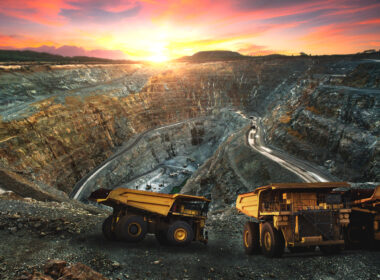Dear Members,
Mining resources has been the hottest sector during this market upturn. Last week, we talked about Ivanhoe Mines running from $2 per share to $13 and Teck Resources soaring from $3 per share to over $32, both in less than a year.
There’s no doubt that investors are flocking towards the mining sector, especially Canadians. Sixty percent of all public mining companies are listed on the Canadian public markets and about half of all mining capital is being raised in Canada.
With so much hype around this sector, how do investors know what to look for?
Investors should understand the process and costs involved in mining before they jump in and make a wrong investment by chasing the markets. When investing in miners, its much more fun and rewarding when you at least understand the basics.
This topic can very easily take up thousands of pages, hundreds of books, and years of schooling, but there are some basic fundamentals average investors can work with. For this week, let’s start with the basics.
The two most important factors in mining is the mining itself, and the feasibility of the project (which we will discuss in more detail next week).
There are many methods of mining but the one most widely used thus far has been open pit and accounts for more than 80% of mines in the United States.
 Open pit/cast or surface mining is a method of extracting ore or mineralization that is found very close to the surface, with a sufficient quantity of ore within a close proximity to make it economically viable to extract.
Open pit/cast or surface mining is a method of extracting ore or mineralization that is found very close to the surface, with a sufficient quantity of ore within a close proximity to make it economically viable to extract.
Think of it as digging a large hole in the ground.
Depending on the geometry and depth of the ore body open pit mining is generally by far the most economical method of extraction for the recovery of low grade (1g/t up to around 3-4g/t for gold) finely disseminated ore. The advantage of open-pit mining, as opposed to underground, is that it is usually easier, cheaper and quicker to bring into production but generally relies on a larger resource base due to economical and social reasons (which we will discuss next week).
Using gold as an example, underground mines usually require at least 4-10g/t (grams per tonne) of gold to be considered economically viable (dependant on a lot of factors such as country of origin and geophysical locations.)
You may have heard the term cut-off grade many times when researching mining companies. Cut-off grade is the minimum metal grade at which a tonne of rock can be processed on an economic basis and determines the workable tonnage of an ore.
Companies determine what it costs per ton of material mined and what the ore values is going to be from that tonne. From this, they can determine how much each oz of gold will cost to mine. For example, a common figure for gold mines in South Africa is anywhere between $300-$400/oz to mine. At today’s current prices, that is a very profitable operation.
But you still have to factor in the size of the mine and what it costs to put the mine into production. If you have a small resource but it costs more than $400/oz to mine, there is a great chance that financiers may not find the project large enough for their appetite, and thus the mine will not go into production – even at today’s prices.
Let’s not forget that you still need approval from the government to proceed. They won’t let you pollute their land and water without adequate and substantial economic benefit.
In short, a mine that appears feasible by the numbers may still not go into production – so don’t expect every company with a promising NI 43-101 to get there.
Before full on production can take place, there are many costly steps involved with bringing a mine into production, even if it is open pit. You have to identify the resource through various sampling methods, determine cut-off grades, and conduct a full on feasibility study before you can even begin production.
Key points to focus on (in most cases) include:
- High Grade Levels – the higher the grade level of ore, the better the project
- Cut-Off Grades, Low vs High – Cut-off grades are essential to determining the economic feasibility and mine life of a project. Increased cut-off grades can reduce political risks by ensuring higher financial returns over a shorter period of time. Conversely, lower cut-off grades may increase project life with longer economic benefits to shareholders, employees, and local communities. In short, a low cut-off grade does not mean a poor project.
- Easy Access – having easy access to infrastructure including water, electricity, and work force cuts down project costs significantly
- Proximity to Producing Mines – the closer the proximity to a producer, the less the infrastructure costs may be
- Indicated and Inferred in NI 43-101’s – Indicated estimate has a higher confidence level that such resources exists by estimating from sampling at places spaced closely enough that its continuity can be reasonably assumed. Inferred estimate is an estimate of resource whose size and grade have been estimated mainly or wholly from limited sampling data, assuming that the mineralized body is continuous and thus less confidence is placed on the data
- Never Rely on Estimates Alone – both indicated and inferred resource estimates in NI 43-101’s DOES NOT factor in the feasibility of its resources
- Place of Operation – a great resource is one thing, but a resource located in an unstable country with an unstable government can spell disaster
- Access to Capital – a well funded company usually means other professionals not only have done their research but believe in the project
- Great Management Team – a project can be great but ultimately, a management has to be able to execute
The fact is that mineable mineral deposits are rare and to bring a deposit into profitable production is even more so. The chances of bringing a raw prospect into production have been estimated at one in 5,000 to 10,000. That’s why there are many instances in which mining companies have revived old prospects and drilled just one more time before a discovery was made.
The great news is that with recent technological advances and the continual growth of resource prices, many projects with low grade ores and past producers are now becoming more economically viable.
Yet, few mining companies have the financial resources to delineate ore reserves too far into the future, which is why the big guns such as Barrick Gold, continually seek out and invest in other gold juniors to increase their reserves. This is yet another reason why a junior with a nearby producer has a much higher chance of going into production because the costs of production are often too high for a junior to fund by themselves.
 The one exception may be Potash Corp of Saskatchewan with mine reserves (at current production rates) sufficient enough for 200 years; as close to an annuity for shareholders as there is in the mining business.
The one exception may be Potash Corp of Saskatchewan with mine reserves (at current production rates) sufficient enough for 200 years; as close to an annuity for shareholders as there is in the mining business.
As a result of the financial hardships and costs of production, most of the world’s store of metals and minerals remain undiscovered. Let’s again use Ivanhoe and Rio Tinto’s Oyu Tolgoi project for example. A resource of that size, after all these year, is now finally getting the go ahead.
Over the next few decades mining will change dramatically as the world’s reserves of a particular commodity become depleted. This will inevitably lead to higher prices which, in turn, will make lower-grade ore economically viable.
Next week, we’ll go into more detail about Mine Feasibility Studies.
Until next week…
Follow this link to receive this weekly newsletter via email: http://equedia.com/newsletter/










